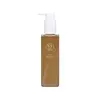What's inside
What's inside
 Key Ingredients
Key Ingredients

 Benefits
Benefits

 Concerns
Concerns

No concerns
 Ingredients Side-by-side
Ingredients Side-by-side

Water
Skin ConditioningCoco-Betaine
CleansingGlycerin
HumectantCoco-Glucoside
CleansingDecyl Glucoside
Cleansing1,2-Hexanediol
Skin ConditioningDipropylene Glycol
HumectantNiacinamide
SmoothingButylene Glycol
HumectantXanthan Gum
EmulsifyingPanthenol
Skin ConditioningCellulose Gum
Emulsion StabilisingEthylhexylglycerin
Skin ConditioningSodium Polyacrylate
AbsorbentPropanediol
SolventCitric Acid
BufferingSorbitol
HumectantCamellia Sinensis Leaf Powder
ExfoliatingDisodium EDTA
Allantoin
Skin ConditioningHyaluronic Acid
HumectantHydrolyzed Hyaluronic Acid
HumectantSodium Hyaluronate
HumectantCaprylic/Capric Triglyceride
MaskingSaccharomyces/Xylinum/Black Tea Ferment
Skin ConditioningCeramide NP
Skin ConditioningHydrogenated Lecithin
EmulsifyingWater, Coco-Betaine, Glycerin, Coco-Glucoside, Decyl Glucoside, 1,2-Hexanediol, Dipropylene Glycol, Niacinamide, Butylene Glycol, Xanthan Gum, Panthenol, Cellulose Gum, Ethylhexylglycerin, Sodium Polyacrylate, Propanediol, Citric Acid, Sorbitol, Camellia Sinensis Leaf Powder, Disodium EDTA, Allantoin, Hyaluronic Acid, Hydrolyzed Hyaluronic Acid, Sodium Hyaluronate, Caprylic/Capric Triglyceride, Saccharomyces/Xylinum/Black Tea Ferment, Ceramide NP, Hydrogenated Lecithin
Water
Skin ConditioningCaprylyl/Capryl Glucoside
CleansingAloe Barbadensis Leaf Juice Powder
Skin ConditioningCamellia Sinensis Leaf Extract
AntimicrobialAroma
Pelargonium Graveolens Flower Oil
MaskingCitrus Bergamia Peel Oil Expressed
PerfumingGlycerin
HumectantFructose
HumectantInulin
Skin ConditioningGalactoarabinan
Saccharide Isomerate
HumectantSodium Cocoyl Glutamate
CleansingDisodium Cocoyl Glutamate
CleansingBenzyl Alcohol
PerfumingCitric Acid
BufferingSalicylic Acid
MaskingSorbic Acid
PreservativePotassium Sorbate
PreservativeSodium Benzoate
MaskingSodium Citrate
BufferingLimonene
PerfumingLinalool
PerfumingCitronellol
PerfumingGeraniol
PerfumingWater, Caprylyl/Capryl Glucoside, Aloe Barbadensis Leaf Juice Powder, Camellia Sinensis Leaf Extract, Aroma, Pelargonium Graveolens Flower Oil, Citrus Bergamia Peel Oil Expressed, Glycerin, Fructose, Inulin, Galactoarabinan, Saccharide Isomerate, Sodium Cocoyl Glutamate, Disodium Cocoyl Glutamate, Benzyl Alcohol, Citric Acid, Salicylic Acid, Sorbic Acid, Potassium Sorbate, Sodium Benzoate, Sodium Citrate, Limonene, Linalool, Citronellol, Geraniol
 Reviews
Reviews

Ingredients Explained
These ingredients are found in both products.
Ingredients higher up in an ingredient list are typically present in a larger amount.
Citric Acid is an alpha hydroxy acid (AHA) naturally found in citrus fruits like oranges, lemons, and limes.
Like other AHAs, citric acid can exfoliate skin by breaking down the bonds that hold dead skin cells together. This helps reveal smoother and brighter skin underneath.
However, this exfoliating effect only happens at high concentrations (20%) which can be hard to find in cosmetic products.
Due to this, citric acid is usually included in small amounts as a pH adjuster. This helps keep products slightly more acidic and compatible with skin's natural pH.
In skincare formulas, citric acid can:
While it can provide some skin benefits, research shows lactic acid and glycolic acid are generally more effective and less irritating exfoliants.
Most citric acid used in skincare today is made by fermenting sugars (usually from molasses). This synthetic version is identical to the natural citrus form but easier to stabilize and use in formulations.
Read more about some other popular AHA's here:
Learn more about Citric AcidGlycerin is already naturally found in your skin. It helps moisturize and protect your skin.
A study from 2016 found glycerin to be more effective as a humectant than AHAs and hyaluronic acid.
As a humectant, it helps the skin stay hydrated by pulling moisture to your skin. The low molecular weight of glycerin allows it to pull moisture into the deeper layers of your skin.
Hydrated skin improves your skin barrier; Your skin barrier helps protect against irritants and bacteria.
Glycerin has also been found to have antimicrobial and antiviral properties. Due to these properties, glycerin is often used in wound and burn treatments.
In cosmetics, glycerin is usually derived from plants such as soybean or palm. However, it can also be sourced from animals, such as tallow or animal fat.
This ingredient is organic, colorless, odorless, and non-toxic.
Glycerin is the name for this ingredient in American English. British English uses Glycerol/Glycerine.
Learn more about GlycerinWater. It's the most common cosmetic ingredient of all. You'll usually see it at the top of ingredient lists, meaning that it makes up the largest part of the product.
So why is it so popular? Water most often acts as a solvent - this means that it helps dissolve other ingredients into the formulation.
You'll also recognize water as that liquid we all need to stay alive. If you see this, drink a glass of water. Stay hydrated!
Learn more about Water